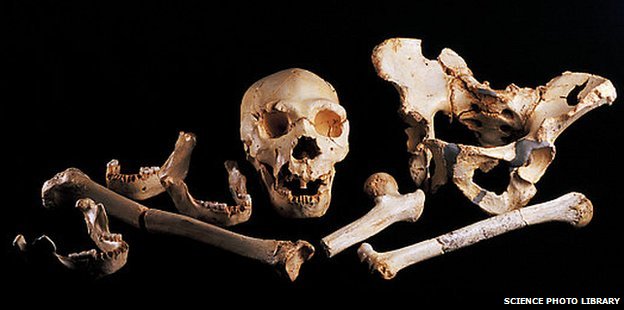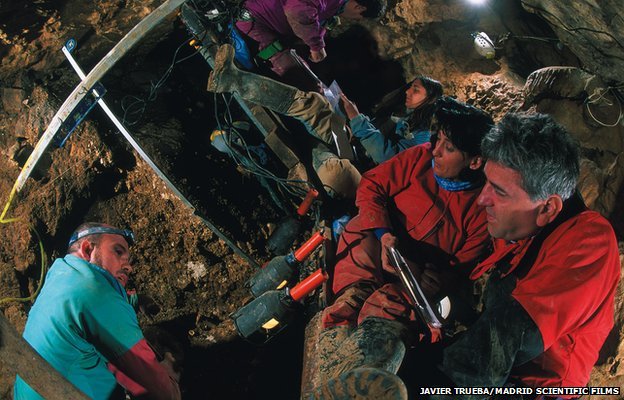Leg bone gives up oldest human DNA


The Pit of Bones has yielded one of the richest assemblages of human bones from this era
That’s the verdict cast by human evolution experts on an analysis in Nature journal of the oldest human genetic material ever sequenced.
The femur comes from the famed “Pit of Bones” site in Spain, which gave up the remains of at least 28 ancient people.
But the results are perplexing, raising more questions than answers about our increasingly complex family tree.
The early human remains from the cave site near the northern Spanish city of Burgos have been painstakingly excavated and pieced together over the course of more than two decades. It has yielded one of the richest assemblages of human bones from this stage of human evolution, in a time called the Middle Pleistocene.
To access the pit (called Sima de los Huesos in Spanish) scientists must crawl for hundreds of metres through narrow cave tunnels and rope down through the dark. The bodies were probably deposited there deliberately – their causes of death unknown.
The fossils carry many traits typical of Neanderthals, and either belong to an ancestral species known as Homo heidelbergensis – or, as the British palaeoanthropologist Chris Stringer suggests – are early representatives of the Neanderthal lineage.
DNA’s tendency to break down over time means it has not previously been possible to study the genetics of such ancient members of the human family.
But the recent pace of progress in sequencing technology has astonished many scientists: “Years ago, geneticists said they wouldn’t be able to find DNA that was older than 60,000 years old,” said co-author Jose Bermudez de Castro, from the National Research Centre for Human Evolution (CENIEH), a member of the team that excavated the fossils.
“Of course, that wasn’t true. The techniques have advanced hugely.”
Researchers at the Max Planck Institute for Evolutionary Anthropology in Leipzig, Germany, under the supervision of Prof Svante Paabo, have been helping drive those advances. The success reported in Nature was the result of applying techniques developed for sequencing the degraded DNA found in Neanderthal fossils to even older specimens.
Prof Paabo, the institute’s director, said: “Our results show that we can now study DNA from human ancestors that are hundreds of thousands of years old,” adding: “It is tremendously exciting.”
The scientists were able to stitch together a near-complete sequence of mitochondrial DNA, or mtDNA (the genetic material contained in the tiny “batteries” that power our cells) from the ancient femur. But comparisons of the genetic code with that from other humans, ancient and modern, yielded a surprise.
Rather than showing a relationship between the Spanish specimens and Neanderthals, which might be expected based on their physical features, the mitochondrial DNA was most similar to that found in 40,000 year-old material unearthed thousands of kilometres away at Denisova Cave in Siberia.
The Denisovans were a sister group to the Neanderthals, with distinct genetic characteristics. Identified only by DNA extracted from a tiny finger bone and tooth, they are, as some researchers have remarked, “a genome in search of a fossil” because there are no substantial remains representative of this group.
By using missing mutations in the old DNA sequences, the researchers calculated that the Pit of Bones individual shared a common ancestor with the Denisovans about 700,000 years ago.
Muddle in the middle

The Pit of Bones is difficult to access but has ideal conditions for DNA preservation
So there are several possibilities as to how Denisovan-like DNA could turn up in Middle Pleistocene Spain. Firstly, the mitochondrial DNA type from the pit came from a population ancestral to both the Spanish hominids and to Denisovans.
Secondly, interbreeding between the Pit of Bones people (or their ancestors) and yet another early human species brought the Denisovan-like DNA into this western population. Prof Bermudez de Castro thinks there may be a candidate for this cryptic ancestor: an earlier human species known as Homo antecessor. One million years ago, antecessorinhabited the site of Gran Dolina, just a few hundred metres away from the Pit of Bones.
Prof Chris Stringer, from London’s Natural History Museum, told BBC News: “We need all the data we can get to build the whole story of human evolution. We can’t just build it from stone tools, we can’t just build it from the fossils. Having the DNA gives us a whole new way of looking at it.”
However, he points out, mtDNA is a small and unusual component of our genetic blueprint, from which only limited conclusions can be drawn. For example, no sign of the interbreeding we now know took place between Neanderthals and modern humans remains in the mtDNA of modern people.
To get the full picture, scientists had to sequence nuclear DNA (that kept in the nuclei of cells) from Neanderthals and compare it with that in present-day populations. Likewise, the true relationships between the Pit people and other ancient populations may only be known if and when nuclear DNA is available.
This will be a challenge given the age of the Spanish fossils, but their good state of preservation – largely a product of the fairly constant temperature inside the cave – gives hope.
“That is our next big thing here, to sequence at least part of the nuclear genome from the individual in the Sima de los Huesos,” Svante Paabo told BBC News.
“This will answer definitively the question of how they are related to Neanderthals, modern humans and Denisovans.”
Source: BBC News



